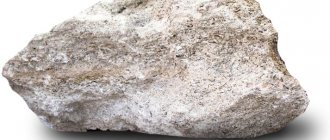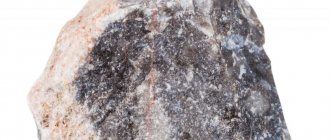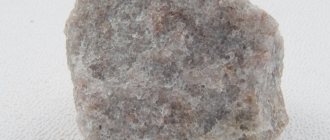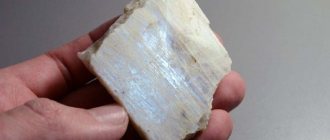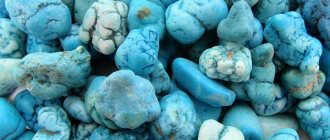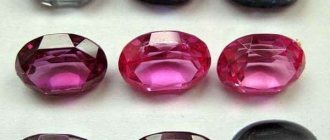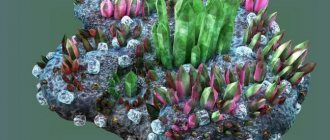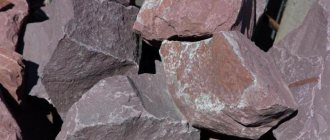The concept of limestone, its chemical formula, what it looks like in the photo
Limestone is a sedimentary mineral of organic or chemogenic origin. It is characterized by a maximum content of calcium carbonate (CaCO3), which is presented in the form of calcite crystals of different sizes. If you examine the material at high magnification under a microscope, you can find impurities of phosphates, silicon, sand and clay particles, and the remains of shells of ancient microorganisms. The chemical formula of limestone, which contains dolomite, is CaMg(CO3)2. The admixture makes the material strong and dense.
The photo shows that the mineral can look different. The rock composed of shells (shell rock) has a fine-grained structure, while its relative chalk has a fine-grained structure. Chalk, marble, stones with inclusions of round shells (nummulitic limestones) are all varieties of limestone. What color is the mineral? The picture shows that it is naturally white. Impurities and their combinations give the mineral unique shades.
Limestone as a mineral, properties of limestone:
Limestone is a sedimentary, clastic rock of organic, less often chemogenic origin, consisting mainly of calcium carbonate (CaCO3) in the form of calcite crystals of various sizes. The composition of limestone includes various impurities; in some cases, individual shells are distinguishable and recognizable in the limestone.
Limestone is a mineral formed in the seas and oceans, as well as in freshwater bodies. Limestone deposits were formed in different geological eras. The formation of most limestones occurred and is currently occurring (for example, coral reefs) due to the extraction of calcium carbonate by living organisms from sea water to build shells and skeletons. The remains of dead living organisms settle and accumulate on the seabed. Calcium carbonate, precipitated from the water saturated with it, is added to the settled limestone debris on the seabed.
Rice. 1. Limestone
Limestone is a natural stone, known and used in construction since ancient times. As a rock, limestone is used to a greater extent than other types of stone, with the exception of marble and granite.
Limestone has a different structure: from very small (on the order of several micrometers) grains to large (the size of a pea).
The color of limestone has a wide range of colors: white, gray, yellow, pink, peach, gray-lilac, brown, brown, blue, as well as all their possible combinations and shades. The color of limestone is determined by the presence or absence of impurities.
Limestone is a soft and porous material that can be easily processed.
Limestone deposits are found on almost all continents, with the exception of Australia. The thickness of the layers varies from several centimeters to hundreds of meters.
Rice. 2. Limestone
Pure limestone in its chemical composition consists of calcite. At the same time, 56% is formed by CaO and 44% by CO2.
contained in limestone can slowly dissolve in water and also decompose into carbon dioxide and corresponding bases. The first process is the most important factor in the formation of karst, the second, occurring at great depths under the influence of the deep heat of the Earth, provides a source of gas for mineral waters.
Characteristics and origin of calcareous mineral
Natural stone limestone is a non-solid sedimentary rock with a maximum content of calcite. The rest of the mineral mass consists of inclusions of particles of other substances (silicon, phosphates, quartz, lime, etc.). Microparticles of the skeletons of simple organisms can also be found in the mass of calcium carbonate. The origin is generally characterized as organic, but there is also an organo-chemical path to the formation of the mineral.
The limestone mineral is mainly formed in the shallow water environment of the sea basin.
Freshwater conditions also allow limestone to be deposited. Its usual form of occurrence is a layer. It can be deposited according to the principle of salt: during the evaporation of water from lakes and lagoons. But the bulk of the stone originated precisely in the depths of the sea, where there were no intense processes of evaporation and drying.
The natural mechanism of mineral formation begins with the work of living organisms. They extract calcite from seawater and build shells. Then the remains of their skeletons accumulate on the bottom surface in a huge mass. The most significant example of the formation of calcite carbonate is the birth, growth and death of coral reefs. It is not uncommon for piece shells to be found on a fracture in a calcareous rock. This variety is called shell rock.
Other species are also named according to the types of organisms and their metabolic products:
- nummulitic;
- bryozoan;
- oolitic.
Marble-like limestone is a separate category. It, in turn, is divided into massively layered and thin-layered types. Under the influence of certain temperatures and pressure, it changes the structure of the crystals and is transformed into marble.
Origin and varieties
LIMESTONE, sedimentary rock composed predominantly of calcium carbonate - calcite. Due to its widespread occurrence, ease of processing and chemical properties, limestone is quarried and used to a greater extent than other rocks, second only to sand and gravel deposits. Limestones come in a variety of colors, including black, but the most common types are white, gray, or have a brownish tint. Bulk density 2.2–2.7. This is a soft breed that can be easily scratched by a knife blade. Limestones boil violently when interacting with dilute acid. In accordance with their sedimentary origin, they have a layered structure. Pure limestone consists only of calcite (rarely with a small amount of another form of calcium carbonate, aragonite). There are also impurities. The double carbonate of calcium and magnesium - dolomite - is usually found in variable quantities, and all transitions between limestone, dolomitic limestone and the dolomite rock are possible. During the process of limestone deposition, water also introduces clay particles, the rock becomes clayey, and the clear boundaries between limestone, clayey limestone and clayey shale are erased. Flint is also a common impurity; it is often present in the form of nodules (flint nodules) or in the form of more or less clearly defined layers. During metamorphism, as recrystallization of calcite covers the entire rock and a mosaic structure appears (an aggregate of clearly defined isometric grains tightly adjacent to each other of approximately the same size), limestone gradually turns into marble.
There are many varieties of limestone. Shell rock is a collection of shell fragments cemented into a cellular aggregate. If the shells are microscopic in size, a loosely bound, soft, finely crumbling, smearing rock is formed - chalk. Oolitic limestone consists of small, fish egg-sized balls cemented together. The core of each such oolite ball can be represented by a grain of sand, a fragment of a shell, or a particle of some other foreign material. If the balls are larger, the size of a pea, they are called pisolites, and the rock is called pisolite limestone. Travertine is limestone formed on the surface as a result of the precipitation of calcium carbonate (calcite or aragonite) from the water of carbon dioxide sources. If such deposits are highly porous (spongy), they are called calcareous tuff. Marl is an uncemented mixture of calcium carbonate and clay. The names of some varieties of limestone are determined by the possible direction of its practical use. For example, lithographic limestone is an extremely dense, compact and uniform stone used in lithography.
Although limestones can form in any freshwater or marine basin, the vast majority of these rocks are of marine origin. Sometimes they are deposited, like salt and gypsum, from the water of evaporating lakes and sea lagoons, but, apparently, most of the limestones were deposited in seas that did not experience intense drying. In all likelihood, the formation of most limestones began with the extraction of calcium carbonate from seawater by living organisms (to build shells and skeletons). These remains of dead organisms accumulate in abundance on the seabed. The most striking example of calcium carbonate accumulation is coral reefs. In some cases, individual shells are visible and recognizable in the limestone. As a result of wave activity and under the influence of sea currents, reefs are destroyed. Added to the limestone debris on the seabed is calcium carbonate, which precipitates from calcium-saturated water. Calcite, coming from destroyed older limestones, also participates in the formation of younger limestones.
Limestones are found on almost all continents, with the exception of Australia. They were formed in different geological eras. The thickness of the layers varies from several centimeters to hundreds of meters. Limestones are common in the United States and occupy 75% of the country's area. In Russia, limestones are common in the central regions of the European part, and are also common in the Caucasus, the Urals and Siberia
History and origin of the breed
Limestone was used in ancient times. The Greeks built temples of the gods from it. In Egypt, the pyramid of Cheops was laid out with hewn monoliths. In Russia and Malta, buildings and cathedrals were erected from it. Archaeologists have found many stone figurines, stucco moldings, and interior items.
Limestone requires sedimentary rock to form. It appears in two ways. In the first case, this is the precipitation of substances from hot solutions, for example near thermal springs. Petrification occurs during the cooling process.
In the second option, the remains of fish skeletons, mollusk shells, and other organic elements settle to the bottom. The thickness of the water contributes to their compaction and subsequent hardening.
This sedimentary rock is also called rock. The explanation is simple: subsidence occurs over a long period of time over a large area. The result is massive strata containing various fossilized minerals. Sediments change the bottom topography, forming hills. After the ancient seas dried up, mountains with sedimentary rocks were left on the earth, where limestone was first found.
Well-known “relatives” of the mineral are marble and soda ash.
The first is formed during the process of metamorphosis, which caused the recrystallization of limestone. The second deposit contains sodium
How is it formed in nature, where is it mined?
The limestone rock appears in the seas from the shells of mollusks, algae, corals and other inhabitants of sea waters. To build shells, some sea inhabitants require calcite, the source of which is water. The remains of tiny creatures accumulate at the bottom and are cemented under water pressure. They can be held together and saturated with minerals by solutions and gas streams that seep through the bottom.
Freshwater conditions also allow rock to be deposited. It can be deposited as lakes and lagoons evaporate. A separate category is marble-like limestone, which under the influence of temperatures and high pressure becomes hard and dense.
The usual form of rock occurrence is a layer. The method of its extraction depends on the location, age and type of limestone. It is extracted in an open way, after preliminary development of the quarry. To do this, the top layer of soil and clay is removed, then pyrotechnic work is carried out, which makes it possible to crush limestone and detach portions of stone. Next, the material is loaded into machines and taken out for processing.
Initially, when mining, people used the breaking method - the material was removed with crowbars and the layers were knocked out using hammers. An alternative to the method is blasting, as a result of which the rock is crushed into crumbs. Using an excavator, it is collected, loaded into dump trucks and transported to factories for processing.
Currently, it is possible to do without an explosion, for which, instead of an excavator bucket, an attachment is used that loosens the rock. The most profitable way to extract limestone is with a milling machine. At the same time, it mines, crushes and transports limestone from the mine to the processing plant.
Limestone composition
And in its pure form, the composition contains only calcite (rarely a small amount of another form of calcium carbonate, aragonite, may be present).
Impurities present:
- dolomite - double carbonate of calcium and magnesium;
- clay particles;
- quartz;
- iron salts
How is limestone formed?
Clam shells, corals, and algae are the basis of limestone. The connecting element is marine mixtures that seep through the bottom, for example, gas flows, various elements and minerals.
What substance is the basis of limestone?
The basis of limestone is the same substance - calcium carbonate (formula: CaCO3). This means that, despite the abundance of forms and variations, all limestones have much in common. First of all, it is the ability to gradually dissolve in water and acids, the tendency to get wet when exposed to moisture, hygroscopicity, and relative softness, making it easy to process.
When heated, limestone decomposes into calcium oxide (CaO) and carbon dioxide (CO2). The decomposition reaction of limestone is used in the production of lime. Another distinctive feature of this material is the biological origin of most of its mass, the presence of imprints of mollusks and other living creatures, whose sediments became part of it
The oldest deposits are hundreds of millions of years old. The main place of its formation and accumulation was the bottoms of seas and reservoirs.
This rock is also interesting because under the influence of water, underground voids and caves are formed in it, many of which have become recreational sites. The caves were actively used by ancient people.
Technical Parameters of Limestone
Dolomites and limestones containing magnesium carbonate have greater hardness. They are more difficult to mechanically influence.
Natural limestone is durable and hard. When crushed, it forms an uneven fracture. Doesn't get wet in water. The physical properties of the rock allow it to be used in construction.
Usually the carbonate compound is white, gray in color. But depending on the presence of impurities, the external color and technical characteristics of limestone change. The minerals contained in the formation not only change color, but also affect strength, stability and determine the scope of application.
The carbonaceous substance colors the rock black, the yellow color is determined by the presence of iron hydroxides, and the greenish color is determined by glauconite.
A description of the technical parameters of the material is contained in the deposit passport. The information collected in the document fully reflects the properties of the breed and its compliance with state standards regulated by law.
The structure of limestone allows us to distinguish types of rock. The texture of the mineral formation is uniform, sometimes there are pores and cavities (voids).
Classification by breed color
Calcium carbonate in its pure form is a white powder; the color of limestone stone depends only on impurities, therefore, it can be used to determine what limestone consists of and what is included in its composition, except calcite. And by the intensity of the color one can judge the amount of impurities. Various shades of the mineral are given by:
- Manganese, which colors the mineral red or brown.
- Iron - giving it a yellow or brown tint.
- Fossilized seaweed is the reason for the greenish color of limestone.
- Occasional inclusions of organic matter will make the stone black or dark gray.
A white or light gray color indicates that the mineral either does not contain impurities or their amount is negligible.
Separation according to the structural features of the mineral
The type and amount of impurities determines what limestone looks like, what its structure is, as well as the physical and chemical properties of the stone. In particular, such a parameter as the solubility of the stone under the influence of water and carbonic acid is important, since it determines the ability to resist corrosion. Based on density, solubility and structural characteristics, rocks are distinguished:
- Dolomite - containing magnesium oxide and being a transitional form between limestone and dolomite. Dolomite limestone is characterized by pronounced layering, it is less soluble than other types of mineral, and therefore is less susceptible to corrosion.
- Marble - with a high percentage of carbonate and organic matter. They have high strength, resistance to aggressive factors and a dense fine-grained structure. They are similar in appearance and properties to marble, but are softer because they have not undergone the crystallization process.
- Coral is a porous, easily destroyed rock.
- Clay - soft, friable and brittle, susceptible to corrosion.
Classification methods
All limestone rocks are divided into types, depending on their origin, composition of impurities, structure and structure.
Variety of limestone
By the nature of their occurrence they can be:
- Organogenic (biogenic origin). Organogenic limestone is formed during the accumulation of fossils of shells and other ancient marine life on the bottom of ancient seas. Most limestones are of this origin. Examples include reef limestone, slurry limestone, and shell limestone.
- Chemogenic. The cause of the formation of chemogenic limestones was the precipitation of calcium carbonate during chemical reactions. An example is pelitomorphic limestone.
- Secondary. This is the so-called detrital limestone, which was formed by the destruction of pre-existing limestones.
Marbled limestone
Based on the composition of impurities, the most common limestone rocks are divided into:
- Marbled limestone. It is formed during the process of gradual compaction of this rock in the earth's crust and is a transitional stage between limestone and marble. Marbled limestone has a higher density.
- Dolomitized limestone (dolomite). This rock contains up to 17 percent magnesium.
- Marls. They contain a large percentage of clay as an impurity.
The structure of limestone rocks can be dense, marble-like, porous, and earthy. Marble-like limestones are characterized by a clear crystalline structure. Earthy limestones, on the contrary, are fragile and friable.
By color: white (for example, Myachkovsky limestone, white limestone), grayish, brownish, yellowish, light pink, brownish, reddish (red limestone); Dark colors are less common. Color and its saturation indicate the quantity and composition of impurities and inclusions.
Based on their application, limestone rocks are divided into:
Ground limestone
- Ground limestone. Has a powdery appearance. Used in construction for preparing mixtures. Ground limestone can be used as fertilizer. Ground limestone can also be used as a top dressing.
- Metallurgical (limestone flux). Used in metal smelting and alloy production.
- Construction (limestone for cladding). Used for cladding buildings and premises. Facing limestone can have good decorative qualities.
- Block. Used for the construction of buildings.
- Sawn limestone. Available in slab form. It is used for interior and exterior decoration of buildings.
- Rubble. Consists of individual cobblestones. Rubble stone is used in the construction of foundations (rubble foundation). The rubble foundation is characterized by great strength and durability.
Impact of climatic conditions on the properties of limestone
Rock is valued as a building material for its low density, pliability to sawing and cutting tools, excellent adhesive properties and a variety of external advantages.
Humid climatic conditions significantly reduce the strength of limestone. Moreover, the stone is characterized by the heterogeneity of the rock, therefore the density here is different. Special attention must be paid to this important point.
The strength of the material and the duration of its operation are affected by its frost resistance. This parameter is much higher in crystalline limestones, but in the absence of pores and cracks in the material.
To prevent the destruction of the natural material during its use, it is necessary to take into account the above-mentioned properties of limestone.
What are formations characterized by?
Among carbonate deposits, the following types of limestone are distinguished:
- dense carbonates (characterized by a homogeneous structure);
- oolitic formations of spherical shape;
- tuffs are formations with large pores, which are durable and easy to process (polished, grinded);
- travertine – sinter formations;
- clayey and bituminous limestones.
The coral limestone in the sediments is supplemented with an admixture of foraminiferal shells and mollusks, and echinoderm shells. The rock that makes up modern reefs has a hard, porous structure and consists of the skeletons of colonies of polyps.
Putilov limestone is known as the main building material used during the construction of the city of St. Petersburg. The name of the rock is associated with the Putilov deposit located nearby.
The density of limestone is average, it does not collapse under the influence of shock loads, and is resistant to abrasion, aggressive acidic environments and salts. It contains small voids formed as a result of rock leaching.
The color of limestone is gray, alternating with dark gray. The crystalline mineral formation of organogenic origin contains dolomite (2-25%), glauconite grains (up to 20%), phosphates (2-3%), grains of silicate compounds (quartz).
Due to its external similarity, limestone is often mistaken for marble. The difference between breeds lies in the form of their formation. For example, the black Portoro marble from which sculptures are created is a sedimentary rock. The structure of limestone is different from marble.
The formation of marble occurs through the process of metamorphic changes and recrystallization of rock. It contains no traces of fossils.
If the conversion process is not completed, the result is marbled limestone. It is this rock that contains white calcite inclusions of bioherms (corals), shells, and fragments of skeletons of other marine inhabitants.
The petrographic and mineralogical definition of the rock is “marble-like limestone.” In the literature on engineering geology, in the section devoted to the classification of rock types, incompletely transformed limestone is called marble.
Dolomitized limestone is a gray and dark gray sedimentary rock composed of calcite and dolomite. The mineral composition of the formations is formed by inclusions of gypsum, anhydrite and silicon, feldspars, pyrite, clayey matter and flora relics (blue algae).
The strength of limestone, which includes magnesium carbonate (about 40%), during compression is 400-1300 kgf/cm², the hardness of dolomite on the Mohs scale is 3.5-4.5.
Types of limestone
Natural stone is characterized by the following parameters:
- origin;
- structure;
- chemical composition;
- structure.
Video: Limestone-shell rock
Origin of the stone
- Organogenic. They are formed from various remains of organic origin, which include: slurry and reef limestone, as well as shell rock.
- Chemogenic. Occur during calcium precipitation.
- Clastic. They are the result of the destructive activity of the oldest limestones.
Limestone structure
- Dense. They are found in almost all formations. For the most part they consist of fragments of shells or shells of various microorganisms and a small part of the smallest grains.
- Microcrystalline or marble-like limestones are subtypes of marble.
- Earthy limestones are chalk.
- Porous. This is the structure of travertine, calcareous tuff, and shell rock.
Chemical composition
- Dolomitized. These limestones contain up to 17% magnesium. As this figure increases, dolomitized limestones pass into the dolomite group, having previously gone through a number of intermediate processes.
- Marbled limestones are transitional variants of formations that result in transformation into marble.
- Marls. Stones containing up to 50% clay particles.
Structure
- Limestones differ in degree of grain size:
- Oolitic. They have a granular structure. The oolite grains are tightly bound together. The grain size does not exceed 1 mm. Oolites have the ability to dissolve. Then voids form in their place.
- Posolite. The structure of these limestones consists of larger grains, the size of which exceeds 1 mm.
Types and varieties of limestone:
There are many types and varieties of limestone : shell rock, chalk, oolitic limestone, pisolite limestone, travertine, tuff, dolomitized limestone, etc.
Shell rock is an accumulation of fragments of shells of marine animals and their fragments, cemented into a cellular aggregate.
If the shells of marine animals and their fragments are microscopic in size (about 5-10 microns), a loosely bound, soft, finely crumbling, smearing rock is formed - chalk . Chalk is up to 75% formed by organic remains - skeletal shells (shells) of planktonic algae-coccolithophores, as well as skeletal shells (shells) of microscopic foraminiferal mollusks.
Rice. 3. Limestone
Nummulite and fusuline limestone consists of the shells of ancient protozoa: the flattened round shells of nummulites and the elongated, spindle-shaped shells of fusulines.
Oolitic limestone consists of small, fish egg-sized balls cemented together. The core of each such oolite ball can be represented by a grain of sand, a fragment of a shell, or a particle of some other foreign material.
If the balls are larger, the size of a pea, they are called pisolites , and the rock is pisolite limestone .
Travertine is limestone formed on the surface as a result of the precipitation of calcium carbonate (calcite or aragonite) from the water of carbon dioxide sources.
If such deposits are highly porous (spongy), they are called calcareous tuff .
Marl is an uncemented mixture of calcium carbonate and clay.
Under the influence of metamorphic processes, limestone recrystallizes and forms marble. Transitional varieties of limestone are called marbled limestones .
Dolomitized limestone is a type of limestone containing up to 17% MgO. With a higher content of magnesium oxide impurities, the rock is called dolomite . The chemical formula of dolomite is CaMg(CO3)2.
There are other varieties of limestone.
Rice. 4. Limestone
Based on their origin, limestones are divided into:
– organogenic limestones – limestones formed due to the accumulation of organic residues (shell rocks, slurry and reef limestones);
– chemogenic limestones – limestones resulting from the precipitation of calcite from solutions;
– detrital limestones – limestones formed due to the accumulation of fragments – products of the destruction of older limestones.
Based on structural characteristics, limestones are divided into dense, porous, marble-like and earthy.
Dense limestones consist partly of extremely fine grains of lime spar (calcite), but mostly of fragments of calcareous shells and shells of various organisms. Typically dense limestones are yellowish, brown, and gray in color and are found in all geological formations, often as thick deposits.
Porous limestones - calcareous tuff, travertine, shell rocks and other rocks. They often contain plant remains, mollusk shells, and the like.
Marble-like or crystalline limestones - various types of marble, marbled limestones.
Earthy limestones – chalk.
Depending on the structure and nature of the grain size, limestones are divided into:
– oolitic limestones – limestones having a coarse-grained structure with calcite formations, round grains of a concentric shell-like structure, more or less densely cemented;
– pisolite limestones – limestones whose grains reach the size of a pea and consist of aragonite.
Rice. 5. Limestone
The nature and degree of grain size of limestones can vary significantly. Sometimes well-defined layering is observed in limestones.
Historical uses of limestone
This natural stone has long been used by man in construction and in other areas of his activity. In the past, buildings, temples, cathedrals and other structures and structures were created from limestone. Limestone made the greatest contribution (among other rocks) to the culture, history and life of former Russia. Such well-known expressions as “white stone Moscow”, “white stone chronicle”, “white stone architecture” are associated with it. The reason for their appearance was white limestone mined near the village of Myachkovo in the Moscow region. It was he who went to the construction of buildings and structures in the central zone of the European part of Russia.
The famous Egyptian pyramids were also built from limestone.
Limestone pyramids
After the advent of millennia, they were well preserved, which could be due to the lack of rain, which can cause corrosion of this material. Another example of the use of limestone rocks is the Great Wall of China. Despite the effects of moisture and acid rain, it continues to fulfill its now recreational function, attracting a huge number of visitors every year from around the world.
In Mediterranean countries, limestone is one of the most common rocks. Therefore, many buildings there are constructed based on this material. The state of Malta is especially distinguished in this regard, where almost all buildings are made of limestone. This stone was also actively used in the construction of buildings in ancient Greece and Rome.
History of limestone products
In Rus', the use of limestone began with the construction of the Church of the Intercession on the Nerl by Prince Andrei Bogolyubsky in 1165. According to legend, the stone for the construction was brought from the Bulgarian kingdom, over which the prince won a victory a year before the construction of the church began. White stone carved reliefs decorated the walls of the building, and the central figure in the composition was King David seated on the throne, holding a psalter with his left hand and performing a blessing with his right.
However, before the Church of the Intercession on the Nerl, the white-stone Temple of Boris and Gleb was built in the village of Kideksha near Suzdal, and the date of its construction is said to be 1152.
Further construction in Rus' was carried out from local limestone. Its extraction began by order of Dmitry Donskoy, who decided to surround the Moscow Kremlin with a stone wall. Since then, white stone has been used everywhere both for construction and for the decoration of buildings with ornaments and portals. White and yellowish Myachkovo limestones became an ideal material for creating exquisite carvings and sculptural compositions, and the craftsmen who worked on them were called stone-cutters.
One of the most beautiful white stone structures was the Church of the Sign, built in the village of Dubrovitsy, not far from Podolsk. It was built from blocks of Myachkovsky limestone and decorated with amazing carvings in the form of leaves and bunches of grapes climbing along the walls. The skill of the builders and stone carvers made it possible to create a temple recognized as one of the masterpieces of world art.
White stone began to be actively used for making bas-reliefs in the second half of the 15th century. It was then that the architect and sculptor Vasily Ermolin made two bas-reliefs installed on the Spasskaya (formerly called Frolova) tower of the Moscow Kremlin. On the outside of the gate was installed the coat of arms of the city of Moscow, depicting St. George the Victorious. And twenty years after this event, in 1466, the side of the tower facing the Kremlin was decorated with a bas-relief with the figure of Dmitry of Thessalonica.
But the peak of popularity of white stone in Rus' occurred at the beginning of the 19th century. Then many sculptures and carved decorations were made, including more than three hundred by the sculptor Ivan Vitali.
Soon after the victory of the Russian people in the Patriotic War of 1812, construction of the Cathedral of Christ the Savior began on Vorobyovy Gory, as gratitude for the intercession of the Almighty and as a monument to the courage of the Russian people. According to the plan of the architect A.L. Vitberg, this grandiose structure should have been visible from anywhere in the capital.
Limestone was chosen as the material for the foundation of the temple. To ensure that its delivery would not be too expensive, the extraction of this stone began in the village of Grigorovo, located not far from Moscow. However, due to the presence of underground streams and the fragility of the soil on the Sparrow Hills, construction had to be completed and another location chosen for the temple - on the banks of the Moscow River, not far from the Kremlin. After the completion of construction on Vorobyovy Gory, Gregorovsky limestone mining was also suspended. They returned to this deposit later, 15 years later, when they began new construction of the temple.
Dense white limestone, mined in the vicinity of Kolomna, was used to decorate the walls. Also, other natural stones were used for internal and external cladding - dark green labradorite, pink Shoksha quartzite, multi-colored marbles. The Cathedral of Christ the Savior took almost 40 years to build, and at the end of the work it looked like a white block, like a giant iceberg. This is how it remained in the memory of contemporaries even after this majestic structure was destroyed.
Since the time of using white stone as a finishing material in Rus', many great architectural masterpieces have been created, some of which are famous not only in the country, but also abroad. Some of them, unfortunately, have not survived to this day, but most of the churches, palaces and estates delight with their beauty and sophistication of decoration to this day.
How is limestone used?
This breed is widely used in various fields:
- Construction and cladding. Limestone in construction is used in the production of mixtures, cement, lime, as well as for cladding walls, stairs, balconies, fireplaces, floors (finishing slabs, etc.).
- Road construction. Lump material is used to create embankments and compact soil. Preference is given to materials with a higher bulk density. It usually increases as the particle size decreases.
- In the metallurgical industry. The addition of limestone improves and facilitates the process of smelting metals and creating alloys.
- In the manufacture of heat-resistant glass.
- In the chemical industry: production of rubber, soda, varnishes and paints.
- As a filter material for water purification and in the food industry.
- For other types of production: production of mineral fertilizers, soap, printing products.
Application of limestone
The properties and structural features of the stone contribute to its widespread use in many areas of the national economy. The main areas in which it is used are:
- Construction and design (cladding of building facades and interiors, installation of floors, steps and fireplaces, landscape design, production of limestone mixtures, cement, chalk and many types of crushed stone, production of decorative elements);
- Glassmaking (one of the components in the production of heat-resistant glass);
- Metallurgical industry (fluxed limestones are used in the manufacture of alloys);
- Road construction (crushed stone of various sizes);
- Cable production, production of limestone solutions for coating welding electrodes;
- Production of tooth powder, crayons for drawing;
- Chemical industry (production of soda, production of rubber and paints and varnishes);
- Limestone is also used as a raw material in soap making, printing and fertilizer production. In the food industry, stone is used as a filter in the production of sugar.
In jewelry, translucent stones painted in pastel colors are used. They are cut for decoration, after which they are mounted mainly in cupronickel or silver frames.
Properties of limestone
Physical properties depend significantly on its composition and structure. Hardness varies greatly depending on its variety. Loose rocks (for example, shell rock) have a volumetric mass of only 800 kg/m3, while for limestones with a crystalline structure it can reach 2900 kg/m3.
Compressibility depends on porosity and ranges from 0.4 MPa to 300 MPa. The lowest compressive resistance is characteristic of shell rock, and the highest is characteristic of crystalline rocks. When wet, it becomes less hard and its strength decreases.
The same deposit may contain limestones with different strength values. Loose rocks such as shell rock and chalk are characterized by high abrasion and crushability. In general, these indicators are higher for limestone than, for example, for granite or marble. Brittle limestones have less frost resistance and are difficult to polish, but they are easy to saw and take the desired shape.
Denser versions of this species, on the contrary, polish well, but are harder to saw. They also have higher frost resistance - from 300 to 400 cycles of freezing and subsequent defrosting.
Physicochemical characteristics
The mineral is formed by combining carbonic acid with calcium. Limestone without impurities has a chemical formula written as CaCO3. Limestone is decomposed by acids H2SO4, CH3COOH, HCl. Calcium remains in solution, carbon dioxide CO2 evaporates.
Physical characteristics of limestone:
- decomposition – insoluble in water;
- abrasion - with friction without effort, the area decreases;
- density – 2.5 g/cm3;
- on the Mohs scale, hardness out of 10 points is 3;
- porosity – 35%;
- water absorption – 0.1–2%;
- dry strength – average;
- water absorption strength – minimal;
- frost resistance – up to – 40 ºC;
- burning - no.
Additional minerals add strength to limestone, reduce porosity to 2–30% and water absorption to 0.1–1%. The crystallized texture can withstand compression of 300 megapascals, shell rock - 0.4 MPa.
Mineral composition by type of limestone:
- dolomitized – Ca + MgO2 (magnesium oxide);
- organogenic, detrital or chemogenic – Ca + SiO2 (silicon oxide);
- ferrous – Ca + FeO2 (iron oxide, colors the structure yellow);
- manganese – Ca + MnO2 (manganese oxide, gives pink color);
- clayey – Ca + Al4[Si4O10](OH)8 (kaolin).
The structure of limestone stones is porous, layered or granular. In the latter case, the texture shows thin, small, large or unequally sized rounded particles.
Medicinal properties
In premises, the air is disinfected with limestone, and a solution is applied to the walls to remove fungus. Water purified with calcite filters is beneficial. It removes allergens, toxic products of viruses and bacteria from the body.
Lithotherapists recommend holding a natural stone in your hands or applying or massaging it to the painful area. The color of the mineral matters.
When and what kind of limestone helps:
- hypertension – blue;
- sleep disorders, depression, neurological diseases – pink, red;
- impaired digestion – yellow;
- diseases of the blood, hematopoietic organs, heart, blood vessels - red.
The mineral has antimicrobial and sorbing properties. Helps with skin diseases, acne. A mixture of powder and water is added to baths, applied to the face, and made into lotions and wraps.
Magic properties
Esotericists advise lawyers, doctors, engineers, and accountants to use limestone. You should carry the stone with you or put a figurine made of it in your office. The amulet will protect you from wrong decisions. It helps creative people to cheer up, find inspiration, and get rid of laziness and apathy.
The yellowish mineral is used during meditation. For a woman, light calcite will attract the attention of the man she likes and will strengthen the affection of those around her. Regardless of gender, a person’s intuition increases, the ability to calculate the result of actions and predict the situation improves.
According to the horoscope, astrologers do not recommend using limestone only for people with the sign of Scorpio. Their energy does not coincide with the stone, so an imbalance begins in love and business.
Limestone is common on most continents. Availability and ease of processing have allowed people to use stone since ancient times. The hardened mineral is used to write, decorate landscapes, build houses, and add to ore when smelting metal. It does not serve only as fuel, although there are even petroleum products in bitumen form.
Healing and magical properties
This amazing mineral has found its use in folk medicine. Since ancient times, the antiseptic properties of limestone and its ability to inhibit the growth and spread of pathogens have been known . The leader in the number of healing properties is ordinary chalk, which is used in the form of fine powder:
- For erysipelas and trophic ulcers.
- As a remedy for heartburn and diarrhea.
- To remove warts.
- As an antidote for acid poisoning.
The magical power of the stone is also known. It is believed that calcite, which is its basis, is able to develop intuition and attract the attention of others. Amulets and amulets made from limestone are recommended to be purchased by people whose professional activities require special attention and clarity: representatives of legal structures, financial workers, and doctors.
Of course, one can be skeptical about the magical properties of limestone, but one cannot deny the enormous significance of this multifaceted and omnipresent mineral - the eternal companion of man from ancient times to the present day.
Zodiac signs
Limestone, the basis of which is calcite, can be recommended to all zodiac signs except Scorpios. Representatives of this zodiac sign are most prone to black magic and the occult, while the energy of the stone is light. That is why strong-willed Scorpios do not find a common language with him.
The rest of the signs of the Zodiac circle can fully experience the positive properties of limestone. Representatives of the astral house, who need clarity and accuracy in their professional activities, will especially feel the help of the stone. These are financiers, accountants, doctors and representatives of legal structures. Back to contents
Use of limestone in construction
Due to the large number of colors and textures, limestone is widely used in the construction industry. In the construction of buildings, limestone can be used as a base material (limestone bricks) or for cladding slabs.
In any case, the pieces of limestone are sawed. The main advantage of this material is that the size of its blocks can be varied. In addition, limestone has very high environmental characteristics, as it is a natural material.
Limestone is also used to design garden and summer cottage plots. It is used to form alpine slides and stone barbecues. Its advantage in this situation is its high durability, aesthetically pleasing appearance and ease of maintenance.
Limestone is also widely used in interior decoration. It is used to decorate balconies and stair railings. Due to its high ductility and easy workability, limestone can be used to make decorations and balusters of any complexity.
In some cases, furniture elements, kitchen and bar countertops, and even decorative elements, such as figurines and vases, are made from limestone.
The video will tell you how to work with limestone when creating sculptures:
Limestone in art
Limestone is used in architecture, sculpture and for decorative and ornamental works. In Russian architecture, chalk limestone was often used in combination with brick and tiles. Marble is especially widely used in art.
Limestone in metallurgy
Ordinary dense limestone is used as fluxes (fluxes) in the smelting of cast iron from iron ores containing silica and alumina as waste rock. Limestone is rated by its fluxing ability, i.e. by the content of calcium oxide and magnesium oxide in limestone without the amount of these substances required to slagging impurities. Flux limestone must be strong and not contain compounds that adversely affect the quality of cast iron.
Limestone in agriculture
Especially loose and soft limestone is used for liming acidic podzolic soils.
Limestone in the printing industry
Certain varieties of chemical sedimentary limestone are used to make lithographic stone.
Limestone
Limestone is a sedimentary rock containing calcium carbonate with numerous impurities.
Often in the block you can find the skeletons of various microorganisms, the presence of silicon, and sometimes clay. Due to its availability, limestone is widely used in construction. It is quite durable, evidence of this is the presence of ancient monuments that are in excellent condition to this day. Easy to use and process. The appearance is a black to white soft rock, although dark brown limestone is more common. In general, according to its structure, it is divided into groups according to different criteria.
Limestone classification
Based on its origin, limestone is divided into: organic (which contains reef limestone, shells, skeletons of microorganisms); chemogenic (contains calcium sediment); clastic (so-called ancient limestone).
Divided by chemical composition:
marble - its formation occurs due to metamorphic processes in limestone layers; dolomite - contains up to 17% magnesium, which can degenerate into marl; clayey - almost half of the clay substances.
According to the structure they are distinguished:
earthy - soft, crumbly; marble - crystalline; dense - granulated from mollusk shells; porous - cavity containing foreign objects.
Features of the structure and use of limestone
Directly pure limestone consists of white calcite, only sometimes containing aragonite (another type of calcium carbonate). In structure, limestone is represented by sedimentary layers of medium density. It can be easily scratched, so there are certain rules for storing and transporting it. Limestone reacts violently when interacting with weak acids. When characterizing the properties, special attention is paid to the hardness, elasticity and density of the rock.
Limestone is extracted using two standard methods: using an explosion or using special equipment. The resulting rubble pieces are sent by conveyor to warehouses, where further processing is carried out. Large layers are cut using diamond wheels into lined slabs and saw blocks. To obtain crushed stone, limestone crumbs are crushed with special machines. By roasting, lime is obtained, which is used for industrial purposes.
As a result of its diverse origins, limestone is used in several fields of construction. Widely used in the construction of buildings, in interior finishing work: stairs, fireplaces, columns, bathrooms, for the production of window sills, countertops, cabinets. Limestone is also used when creating landscape design in gardens and parks, as it has sufficient density and wear resistance. Limestone of various colors is used for design, which gives the decorative items a special touch. It is used to create sculptures, vases, decorative balusters and others.
Decor items look aesthetically pleasing and are easy to care for.
In the construction of buildings, block slabs and bricks of various textures and colors are used. Slabs with smooth surfaces are used as external finishing of buildings. In addition to such qualities as frost resistance and stability, this material is also environmentally friendly.
In addition to the construction industry, universal limestone is also used in other industries: metallurgical, agricultural, medical, railway, as well as food and many others. For example, it is used to purify water from contaminants in drilling wells, and in gardening areas, limestone plays the role of protecting plants from pests.
Positive properties of limestone for construction
When comparing this breed with other building materials, there are a number of advantages:
perfect safety of organic breed; plastic structure from which you can create the desired shape; the strength of limestone in the example of ordinary facing tiles or bricks is much higher, even with constant adverse effects of external conditions; the porous structure allows you to absorb excess moisture, due to which the room will be absolutely dry, and allowing air to pass through creates a favorable microclimate; high sound and thermal insulation makes limestone an ideal material for interior work.
It is difficult to overestimate the qualities of limestone in the construction industry. This is the best construction and finishing material among its kind, so you should always take it into account on construction sites and in decorating premises.
Read how I got caught with crushed limestone in concrete in this article.
Destruction of limestones
When using limestone in sculpture, the instability of this stone in cold weather is often discovered. This is explained by the fact that they belong to sedimentary rocks, during the formation of which a large amount of moisture is stored, filling the pores. Consequently, freshly mined stone is a material extremely saturated with water. Therefore, the limestone block for sculpture should be broken out in the spring and processed immediately so that the sculpture has time to dry in warm air. After complete drying, the limestone sculpture can be installed outdoors. The destruction of limestone and marble sculptures often occurs due to iron pylons and brackets; rust quickly forms on them, which grows in volume and tears the stone.
To prevent this type of destruction of limestone and other rocks when installing brackets and pyrons, the holes should first be filled with a solution of cement and sand in a ratio of 1 part cement to 5 parts sand. Or use titanium brackets or stainless steel brackets instead of iron pylons.
Chemical methods for compacting marble and limestone
To increase the resistance to climatic factors of porous natural and artificial stone materials, water-repellent organosilicon compounds and fluids (magnesium and zinc silicon fluorides) can be used. The latter are intended for surface treatment of sculptures made of concrete, marble and limestone. When fluorinated, as a result of the chemical interaction of silicofluoride with oxide hydrate or calcium carbonate present in marble and limestone, the pores and capillaries are compacted, as a result of which water absorption decreases and the strength and frost resistance of the stone material increases, and the dustiness of the surface of the sculpture decreases.
Benefits of using limestone
Compared to other materials, limestone has the following advantages:
- The undoubted advantage of limestone is its high environmental friendliness;
- It lends itself perfectly to processing, which allows you to give it almost any shape and texture;
- Unlike, for example, brick or facing tiles, limestone retains its appearance for a very long time. Even if its surface is constantly exposed to adverse weather factors. That is why limestone is often used when cladding building plinths;
- Limestone has a porous structure, which allows it to perfectly absorb moisture from the environment. Therefore, the humidity in the room will be at the optimal level;
- High heat and sound insulation characteristics make the material ideal for exterior and interior decoration.
As you can see, limestone is an excellent material that can be used in many industries, mainly in the construction industry. Its excellent qualities allow us to say with confidence that this is the best material in its category.
Sources
- https://zolotoe-runo-sl.ru/podelochnye-kamni/chto-takoe-izvestnyak.html
- https://chudoogorod.ru/prochee-dacha/kak-ispolzuyut-izvestnyak.html
- https://natrukodel.ru/prochie/izvestnyak-svoystva
- https://ratingstroy.ru/stroitelnye-materialy/plitka-mramor-granit-kamen/kamen-izvestnyak-i-ego-primenenie-v-stroitelstve-2/
- https://1nerudnyi.ru/gde-ispolzuetsya-izvestnyak/
- https://jewel-spb.ru/podelochnye/chto-delayut-iz-izvestnyaka.html
- https://stroyres.net/vyazhushhie-materialy/neorganicheskie/izvestniak
- https://ural-granit74.ru/catalog/izdeliya-iz-izvestnyaka/
- https://zen.yandex.ru/media/id/5d31cdbb520a9b00adb3bd8c/izvestniak-proishojdenie-cveta-i-sposoby-uplotneniia-naturalnogo-kamnia-604a096e013fe76fa3d3ee92

